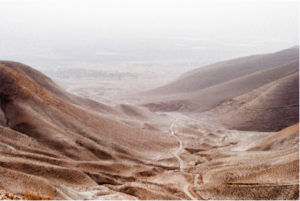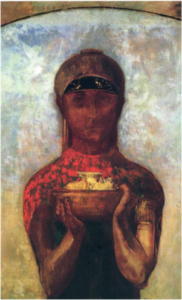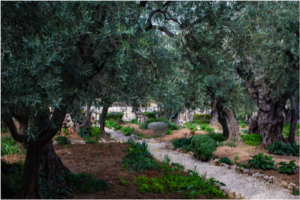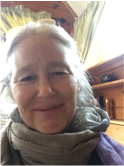As we actually taste the flavor of what Jesus is teaching, we begin to see that it’s not proverbs for daily living, or ways of being virtuous. He’s proposing a total meltdown and recasting of human consciousness, bursting through the tiny acorn-selfhood that we arrived on the planet with into the oak tree of our fully realized personhood. He pushes us toward it, teases us, taunts us, encourages us, and ultimately walks us there.
~ Cynthia Bourgeault, The Wisdom Jesus, pg. 27
 What did Jesus teach—”on the ground” as we say these days—and how? These chapters center on the living Jesus and his teachings. Cynthia encourages us to look beyond our story of Jesus—the Jesus we learned about as a child or through the cultural assumptions of our times—to the Wisdom master he was. A master who taught “a complete, mutual indwelling…where the whole and the part live together in mutual loving reciprocity, each belonging to the other and dependent on the other to show forth the fullness of love” (pg. 31). This lies at the heart for Jesus: the Kingdom of Heaven is here and now. But how do we cross that bridge?
What did Jesus teach—”on the ground” as we say these days—and how? These chapters center on the living Jesus and his teachings. Cynthia encourages us to look beyond our story of Jesus—the Jesus we learned about as a child or through the cultural assumptions of our times—to the Wisdom master he was. A master who taught “a complete, mutual indwelling…where the whole and the part live together in mutual loving reciprocity, each belonging to the other and dependent on the other to show forth the fullness of love” (pg. 31). This lies at the heart for Jesus: the Kingdom of Heaven is here and now. But how do we cross that bridge?
Manifesting as a “life lived out of this transformed consciousness,” the Kingdom of Heaven is a state of being that is “both possible and intended for human beings” (pg. 32-33). Our daily lives are not severed from, but alive within it. The awareness of this reality grows in us in the field of our own hearts. I felt a sense of freedom offered in these chapters that I had not picked up on in quite this way before. Following on her image of our binary mind as our “egoic operating system,” Cynthia says, “we can make the choice to upgrade” (pg. 31); that Jesus has been calling to us that “life is going to look a whole lot different when you do” (pg. 34). We participate in the upgrade.
We need our binary minds to navigate this world. Everything belongs. Beyond that, though, is a much larger reality and a greater order of things, imperceptible to the dualism that must divide to comprehend. “We do have the capacity, if we so choose, to shift.” Through the heart’s innate ability to bring us into alignment with our whole being, we connect with a much broader awareness that is “ours for the choosing” (pg.35). Jesus invites us to meta noia: to go beyond, into larger mind (pg. 37). We are offered a way to slip out of the grip of dominant mind and the comfort of our identities, by dropping into our hearts. Cynthia says, “the heart keeps us aligned with our innermost, with what we truly know” (pg. 36). Rather than being outside of things, we discover we are a part of it all. Rather than standing here and looking there—we are simply Here. Awake and receptive to a deeper perception.
The teachings of Jesus can help us get Here. As a Wisdom master, through koan-like parable and saying, image and logion, he takes our surrendered hearts by the hand, “so that what is hidden will become manifest” (pg. 60). Cynthia uses the parable from Matthew of the laborers in the vineyard (pg. 38-39) to begin to open the perspective of the awakened heart for us. She asks us to notice: when we hear these teachings from a Wisdom perspective, what do we notice in ourselves? Do we viscerally experience an opening into a seamless reality, a far deeper Wisdom, revealed by the skillful hand of a master teacher? Do we taste Bruno Barnhart’s recognition energy, brought to fierce, present, aliveness—enabling us to “ground truth a spiritual experience in our own being” (pg 8)?
This morning, I awoke to a sense of freedom in Cynthia’s outstretched hand. That word choice is like offering birdseed to a chickadee. I follow it to a visceral experience of recently choosing to see a deeper level of my own self-will. It echos within me, connects to her emphasis on choice, but I didn’t know that right away. I simply sensed the freedom. Now it feels like a vital, subtle substance, resonating in the parable of the laborers in the vineyard as well. Her words, the parable, my experience: I sense something more is being touched.
The parable’s landowner gives a certain value to our choosing with the words on page 39: “I choose to give to this one as I give to you. Am I not allowed to do what I choose with what belongs to me?” My heart opens with this, deepening  over the course of the day. A newness emerges: a sense of the beauty and the gift of our very beings. Jesus is showing us what is being offered within and through a human being in alignment with the Great Resonant Heart. What a beautiful affirmation of our responsibility to choose with our whole being. First of all, to deeply accept what belongs to us—our choices, what we have to give, our receptivity and where we give from, and so much more—and to wield it well.
over the course of the day. A newness emerges: a sense of the beauty and the gift of our very beings. Jesus is showing us what is being offered within and through a human being in alignment with the Great Resonant Heart. What a beautiful affirmation of our responsibility to choose with our whole being. First of all, to deeply accept what belongs to us—our choices, what we have to give, our receptivity and where we give from, and so much more—and to wield it well.
It echoes with the oil in the parable of the five wise bridesmaids. “The oil symbolizes something that has to be individually created in you through your own conscious striving. Nobody can give it to you; nobody can take it away from you” (pg 52). The teachings are in dialogue, entering in through their resonance in this particular way, this day, in me. And it will be fresh and new every time I pause, let go, and connect.
Cynthia continues with her discourse of the Beatitudes, and offers a gorgeous portrait of the call and response through each saying, showing us how Spirit works upon us as we take up our work with the elements we have been given. Giving and receiving in a dynamic dance with God, we are becoming truly human. We soften, open, become teachable, do the work in form, live our yearning. It is a fourfold path, Cynthia says, to awakening consciousness “embraced through an attitude of inner receptivity; a willingness to enter the flow; a commitment to domesticate those violent animal programs within us; and above all, a passionate desire to unify the heart” (pg. 47).
The nature of the choice intensifies with the path. Cynthia goes on to unpack several of the most challenging parables, “the hard teachings” and six of the logions, or sayings, from Gospel of Thomas. In their challenge to our “binary operator” each of these offer us a place to work, to find a foothold. She suggests: “Allow the parable to become a mirror that reflects back to you your own state of consciousness.” Welcome, if you will, the “classic strategy” of a master teacher! Tenaciously “short-circuiting that grasping, acquiring, clinging, comparing linear brain to open up within a whole new mode of perception” (pg. 50).
Something in these Wisdom teachings will trigger us. That is their design and purpose: to undo. The places where we are aware of our own reaction—our clinging, unwillingness to let go—these are the places where we can put the alchemical kettle on and light the fire ourselves. We work with our own transformation, enter in. Lay down our identification as the person we thought we were, and wanted to be, and—in our own beautiful way—throw it all in the pot.
“You have to do the work yourself” (pg. 52). Cynthia’s vision is all about the nitty gritty of the radical transformation Jesus is mirroring for us. Christianity’s deep truth, visible only when we set foot upon the path, begin to notice the alchemy in our own life—and the new arising emerging. To participate in it a certain rearrangement is necessary: how we perceive ourselves and the world around us—even the relational substance of God and creation.
This life provides each of us with a very particular vehicle for alchemy, and we are in the best of company. As we begin to accept our broken jagged edges and work with them—at times patiently and compassionately, at times not so gracefully—we are taught how to stir the pot. We learn by experience to trust the unknown that is our constant companion, treasure our limitations and constrictions as the great teachers that they are. The questions that arise, as Rilke says, may be lived rather than answered. The answers will come. We are given what is necessary to bear the larger field of the heart. In logion 22 Jesus says, “When you are able to make the two become one…then you will enter in” (pg. 57). We empty ourselves to enter in, to become.
My friend reminds me of Teilhard’s prayer: “Above all trust in the slow work of God. We are quite naturally impatient in everything, to reach the end without delay” (from a letter to Marguerite, sent July 4, 1915). So we gather our forces, and patiently, compassionately, we stir the pot, grateful. We stir for God and all those who watch over us. We cook for the planet, for our friends and loved ones, for the past and future and all the generations. For all life, and for all we do not know. This is my prayer.
 Out of that pot we pop, from time to time—noticing the broad reaches, the depths of love, the force field of connection, the taming of our own desperate will—to find below and beyond a freedom and compassion, growing. A spiritual substance growing slowly within us; “profoundly joyous because the spaciousness emerging from this new portrait of Jesus gives us the freedom to go deeper” (pg. 61). And to go deeper again. Through the teachings, Jesus shows us the way in real time, as we take each step.
Out of that pot we pop, from time to time—noticing the broad reaches, the depths of love, the force field of connection, the taming of our own desperate will—to find below and beyond a freedom and compassion, growing. A spiritual substance growing slowly within us; “profoundly joyous because the spaciousness emerging from this new portrait of Jesus gives us the freedom to go deeper” (pg. 61). And to go deeper again. Through the teachings, Jesus shows us the way in real time, as we take each step.
Image credits from the top: Road to Jordan, photo by Eddie & Carolina Stigson on Unsplash; painting Cup of Mystery by Redon, courtesy of wikimedia; photo of the Garden of Gethsemane, by Stacey Franco on Unsplash
 Laura Ruth is dedicated to an embodied, practical Wisdom, awake and alive in daily life in her inner life and outer work, whether it is in her one-with-one private practice or with the Wisdom Waypoints Living Wisdom groups and book circles. Laura lives in Vermont on the land of the Abenaki people, with her dear husband, near their sons, two grandchildren and her mother.
Laura Ruth is dedicated to an embodied, practical Wisdom, awake and alive in daily life in her inner life and outer work, whether it is in her one-with-one private practice or with the Wisdom Waypoints Living Wisdom groups and book circles. Laura lives in Vermont on the land of the Abenaki people, with her dear husband, near their sons, two grandchildren and her mother.
A Note from Wisdom Waypoints:
We will be traversing Chapters Three, Four and Five on the Last Tuesday in February in the Wisdom Waypoints book circles. We invite you to join us in spirit, from wherever you are, as small circles across the country and around the world enter into silence and practice together, and the reading and discussion of these pages.
Here’s the link to the first post in the series, The Wisdom Jesus Book Circles launching January 31, 2023
